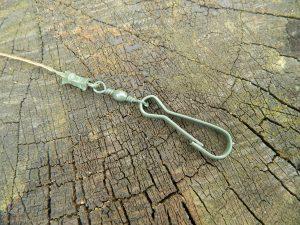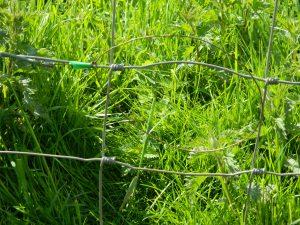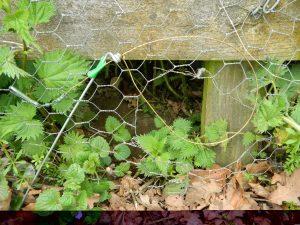Fence Snaring Rabbits

From Steve Caple – I have had a few enquiries just lately about the quick release fence snares that I use and how they are constructed and utilised. Anybody who has tried to tie, or worse still, untie a snare that has been directly fixed to a fence with frozen fingers in the depths of winter will quickly appreciate the merits of the quick release attachment method. There are always new innovations and methods that are devised to supersede the previously accepted practises and this is what keeps the trapping profession constantly evolving. I do not claim originality for devising this method of fixing as I had seen it used before albeit for clips on squirrel snares, but I thought I could adapt and utilise it for rabbit fence snaring. I have also seen fox wires that benefit from a similar type of system.
The snares are simplicity itself to construct and are basically a normal length peg snare with a swivel and snap-clip clasp (teardrop loop) crimped to the holding end of the wire instead of the normal figure-four tealer. If you look at that well known on line auction site you will find packets of both swivels and snap clips readily available at minimum cost. The swivels I found worked the best were the ones used on angling set-ups, but do try to get the more robust type. The swivel is fitted to the wire using a ratchet crimper and aluminium ferrule, the type used on the straining wire when installing bird netting. I spray mine a green or brown colour just to help them blend in a little and be a little less obtrusive, but in reality I think it makes little difference to their catching ability once fitted to a fence. For the tealer I use approx 9 inch lengths of wire with a twist loop at the top end which has the wire passed through it prior to attaching the swivel and clip. The snare loop is then held onto the tealer with a couple of turns of electrical insulation tape. The tealers can then just be threaded through the netting or pushed into the ground to hold the noose in the correct position over the hole the rabbit jumps through. I also have a few wires made up minus the tealer for directly taping to a square netting fence. I have a trapping bag full of ready set up wires that I can just exchange for ones that have made a catch when doing the morning rounds, this saves considerable time as the wires that have caught can be taken home and straightened out and re-set at my leisure.

Setting the fence snares could not be simpler as just described, but choosing where to set them can be a little more difficult. There are two commonly used types of fencing; the square netting type, often referred to as pig or sheep fencing and the small gauge wire netting, usually the type used for rabbit proofing an area. With the rabbit netting it is easy to see where the rabbits have breached it, either by pushing under or more commonly where they have bitten through it to leave a large aperture. It’s often hard to believe that rabbits can chew through wire, but they are persistent little beggars and will eventually create an opening big enough to jump through. I can testify to this as I am constantly monitoring the rabbit netting around the golf course, and repairing the holes where necessary. For a hole a little way up the netting the snare noose needs to cover opening leaving enough space for the rabbit to get its front feet underneath the bottom strand of the snare loop. Similarly, if the rabbit is squeezing underneath the netting, the bottom of the snare wire needs to be an inch or so up from the ground to enable the rabbit to get its front feet under the snare. In both cases, the openings can be enlarged if needed to facilitate the correct setting. When setting in square netting you firstly have to ascertain which square the rabbit is jumping through. In square netting, if installed correctly, you will notice the squares start off reasonably small at ground level and gradually get larger towards the top end of the fence. This is to stop livestock, and especially lambs, from getting their heads through the netting, but they still often manage to get their heads trapped when seeking fresh grazing beyond the fence line. Nearly always the rabbits will be jumping through the second square up from the bottom, and you can usually spot where the wire is tainted with mud from the animal’s feet, but occasionally they will use the bottom square or push under the fence altogether. This is where your powers of observation and field-craft will come into play as it is entirely down to your judgement as to where you set the snare. When clipping the snare on to the wire, try and fix it around a wire junction point, so as it encompasses a vertical and horizontal strand, this way it will not slide along a horizontal wire allowing increased movement. With rabbit netting this problem is not an issue as the small gauge wire apertures prevents this from happening. Use as large a snare loop as you can and don’t worry if the top of the noose overlaps the square above a little, the crucial bit is there must be that little gap between the bottom of the snare loop and the fence.

Don’t forget to mark the locations of your fence wires as often when they contain a catch the trapped rabbit will crouch the far side of the netting trying to evade detection. It’s entirely up to you how you do this; I like to twist a freezer bag tie to the top strand of the fence above the snare, or you can use a cable tie instead but do make sure they are marked in some way as it makes the job of checking them so much easier. There are a few things worth mentioning before you embark on a fence snaring exercise and the main one is to make sure there isn’t going to be any livestock in the field you intend to snare. Bullocks and cattle are prone to licking brass wire snares for some reason; maybe they contain some mineral element I don’t really know, but what I do know is you don’t want some hefty beast with its tongue entangled in a snare. When you intend to set a snare beneath wire netting do make sure that a fox or a badger is not using the same run. Often they will share an entry or exit point but you can usually tell by looking for any hairs that may be caught on the bottom strand of wire. If in any doubt then ere on the side of caution and don’t set a snare in that particular run. It’s a good ploy to try and avoid these overly large scrapes beneath fences and only set in the ones that are obviously only used by rabbits.

If you think you are likely to be troubled by foxes or badgers then checking the wires shortly after dark to remove any early trapped rabbits is a wise move. A squeal from a trapped rabbit will be music to the ears of any carnivore within earshot and they will quickly discover your line of snares. If they are not a problem then its best to leave wires undisturbed overnight and to check them at first light. I always aim to set my last snare when it is nearly too dark to see and have a quick check on the previously set snares on my way back to the vehicle. In areas of heavy rabbit traffic it is often possible to remove half a dozen rabbits on the walk back. Breezy, dry, and mild nights will be the most productive whereas frost, snow and nights of heavy dew will be less so. For some reason, I have often caught well on a foggy night but quite why this should be I have yet to work out, but I feel sure there must be a logical explanation. Maybe one of my dear readers can offer a suggestion as to why this should be?
© Steve Caple 2017